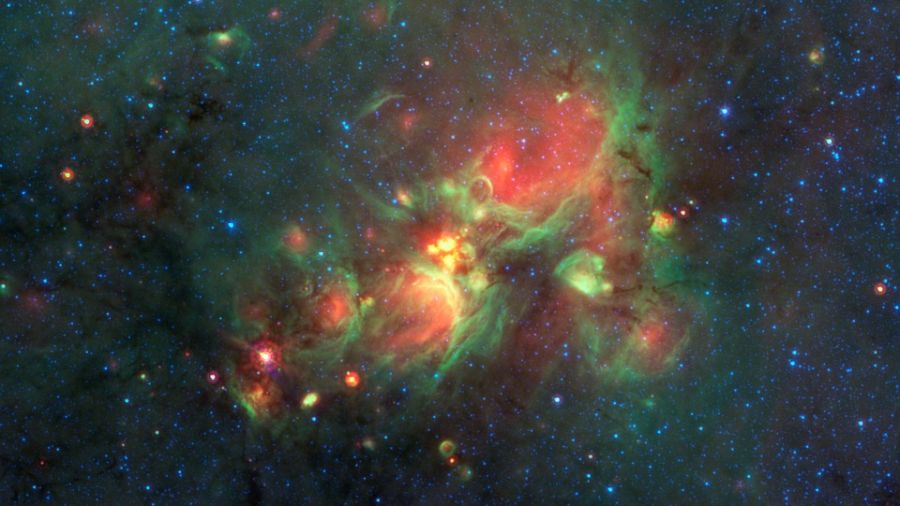The History of Astronomical Observatories Around the World
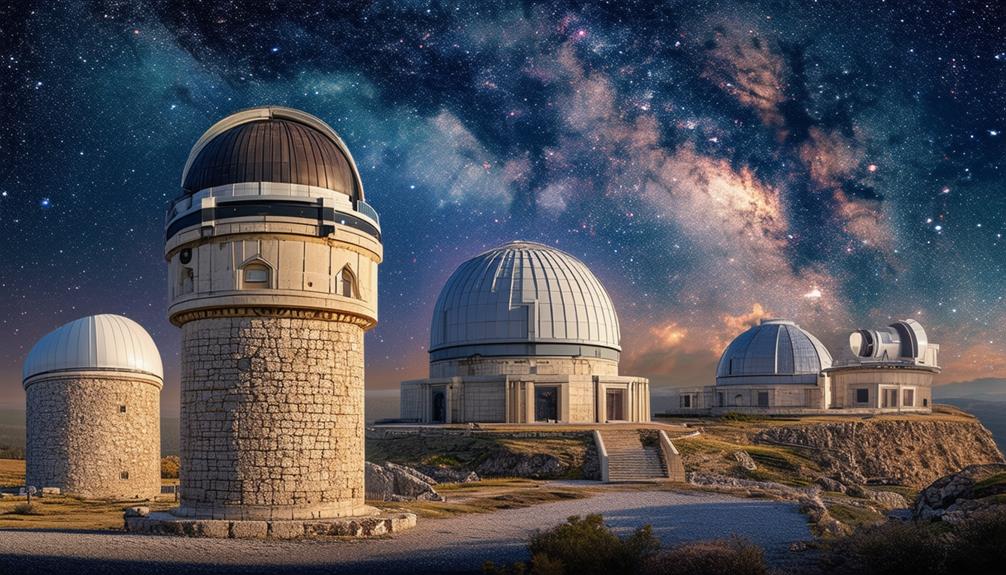
Exploring the history of astronomical observatories reveals that these structures have always been more than mere buildings; they serve as gateways to understanding the universe.
Ancient sites like Stonehenge and El Caracol showcase early human efforts to track celestial movements.
Medieval Islamic observatories in Damascus and Baghdad highlight significant contributions to astronomy, further enriched by the Renaissance period's revolutionary figures such as Copernicus and Galileo, who challenged prevailing beliefs.
The advancements did not stop there; the story continues to unfold, becoming increasingly fascinating with each discovery.
Ancient Observatories
Exploring ancient observatories reveals their ingenious design for tracking celestial events with remarkable accuracy. Stonehenge, dating back to around 3000 BCE in England, stands as one of the earliest known observatories, aligned with solstices and equinoxes, showcasing an advanced understanding of astronomical phenomena.
In Uzbekistan, the Ulugh Beg Observatory, constructed in the 15th century, continues the star cataloging practices initiated millennia earlier. Similarly, the Radkan Tower in Iran, built by Nasir al-Din Tusi in the 13th century, exemplifies the region's dedication to precise astronomical observations.
In the Americas, the Mayan observatory El Caracol, built around 906 CE in Chichen Itza, Mexico, meticulously tracked the movements of celestial bodies like Venus.
In Armenia, the Zorats Karer site, dating back to the Bronze Age, provides evidence of early astronomical alignments, reinforcing the global nature of ancient stargazing practices.
These observatories, spanning different continents and eras, underscore a universal fascination with the stars and the impressive ingenuity of ancient civilizations in tracking celestial events.
Medieval Islamic Observatories
Medieval Islamic observatories, which emerged as early as the 9th century CE, significantly advanced astronomical research through precise star cataloging and the development of sophisticated instruments. Located in key cities like Damascus, Baghdad, and Maragheh, these observatories played a crucial role in enhancing the understanding of celestial phenomena during the medieval period.
Key figures such as Nasir al-Din al-Tusi, who worked at the Maragheh observatory in Iran, made significant modifications to Ptolemaic astronomy, improving the accuracy of celestial measurements and refining planetary models. Scholars like Al-Biruni, Al-Khwarizmi, and Al-Farghani were instrumental in advancing astronomical instruments and methodologies.
Below is an overview of prominent medieval Islamic observatories and their contributions:
| Observatory | Location | Notable Contribution |
|---|---|---|
| Damascus Observatory | Damascus | Early star cataloging |
| Baghdad Observatory | Baghdad | Development of astronomical tables |
| Maragheh Observatory | Iran | Refinement of Ptolemaic astronomy |
| Samarkand Observatory | Samarkand | Advances in celestial measurements |
| Cairo Observatory | Cairo | Innovations in planetary models |
These observatories not only advanced medieval astronomical knowledge but also laid the groundwork for future scientific achievements, influencing subsequent generations of astronomers and scientists.
Renaissance Innovations
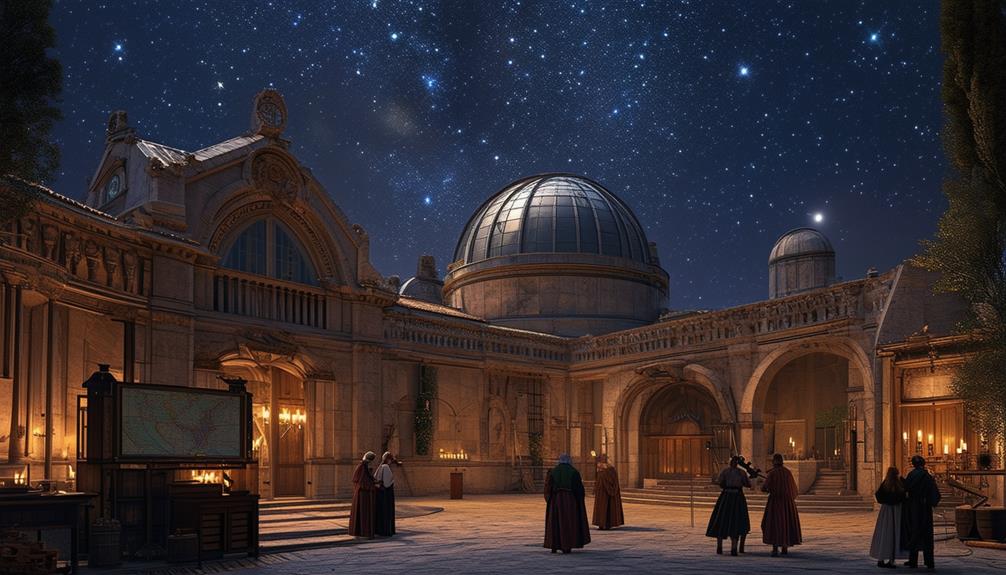
During the Renaissance, astronomers like Copernicus and Tycho Brahe revolutionized our understanding of the cosmos through groundbreaking theories and precise observational data. This period marked a significant shift towards empirical observations and the use of advanced astronomical instruments. Renaissance astronomers were pioneers in challenging long-held beliefs and paving the way for modern astronomy.
Tycho Brahe, for example, meticulously recorded the positions of celestial bodies without the aid of optical telescopes, producing data that was crucial for Johannes Kepler's laws of planetary motion. His observatory, Uraniborg, was equipped with state-of-the-art instruments, facilitating remarkably accurate measurements.
- Direct observations: Renaissance astronomers prioritized firsthand observation and data collection.
- Innovative tools: The era saw the development of new instruments, enhancing the accuracy of celestial measurements.
- Heliocentric model: Copernicus's theory, which placed the Sun at the center of the solar system, fundamentally changed our understanding of the cosmos.
Galileo Galilei further transformed astronomy by using optical telescopes to observe the heavens, discovering moons around Jupiter and the phases of Venus. These observations provided strong evidence against the geocentric model and underscored the importance of empirical data in astronomy. The innovations and discoveries of the Renaissance laid the foundation for subsequent astronomical advances.
Early Telescopic Observatories
The development of early telescopic observatories began with Galileo's pioneering optical telescope in 1609.
Sir William Herschel later advanced this field with his innovative 48-inch mirror telescope.
These advancements significantly transformed our methods for measuring and studying the cosmos.
Galileo's First Telescope
In 1609, Galileo Galilei's construction of the first optical telescope marked a revolutionary leap in observational astronomy. With a magnification of around 20x, Galileo's telescope allowed him to observe celestial objects with unprecedented clarity. Among his groundbreaking discoveries were the rugged surface of the Moon and the four largest moons of Jupiter, which he named the Medicean Stars.
Using his optical telescope, Galileo made several observations that challenged the prevailing geocentric model of the universe. His observations of Jupiter's moons provided concrete evidence that not all celestial bodies orbited Earth. Additionally, his detailed studies of the Moon revealed that it wasn't a perfect sphere, contradicting the Aristotelian belief in the celestial perfection of heavenly bodies. These findings strongly supported the heliocentric model proposed by Copernicus, which posited that the Earth and other planets orbited the Sun.
- Revealed the Moon's rugged surface
- Observed Jupiter's four largest moons
- Supported the heliocentric model
Galileo's work with his telescope not only opened new windows to the cosmos but also fundamentally shifted our understanding of the universe. His pioneering efforts paved the way for the development of more advanced telescopes and modern observational techniques, laying the foundation for modern astronomy.
Herschel's Reflector Innovations
In the 18th century, Sir William Herschel significantly advanced the field of astronomy through his innovative use of reflector telescopes. At his Observatory House in England, Herschel developed groundbreaking reflector telescopes, including a remarkable 48-inch mirror telescope. This instrument greatly enhanced observational capabilities, allowing astronomers to observe celestial objects with unprecedented resolution and brightness.
Herschel's reflector telescopes revolutionized astronomy by providing clearer and more detailed views of the night sky. His innovations in telescope design showcased the superiority of reflective mirrors over traditional lenses. These advancements enabled Herschel to observe distant galaxies, star clusters, and nebulae with exceptional clarity.
The Herschels' observatory became a pivotal site for modern astronomy, illustrating how improved telescope design could expand our understanding of the universe. William Herschel's work laid the groundwork for future astronomical observatories and their advanced instruments.
His pioneering efforts with reflector telescopes not only advanced technology but also broadened our cosmic horizons, facilitating the study of the universe in greater detail than ever before. Herschel's legacy continues to inspire modern astronomers and telescope engineers worldwide.
Modern Ground-Based Observatories
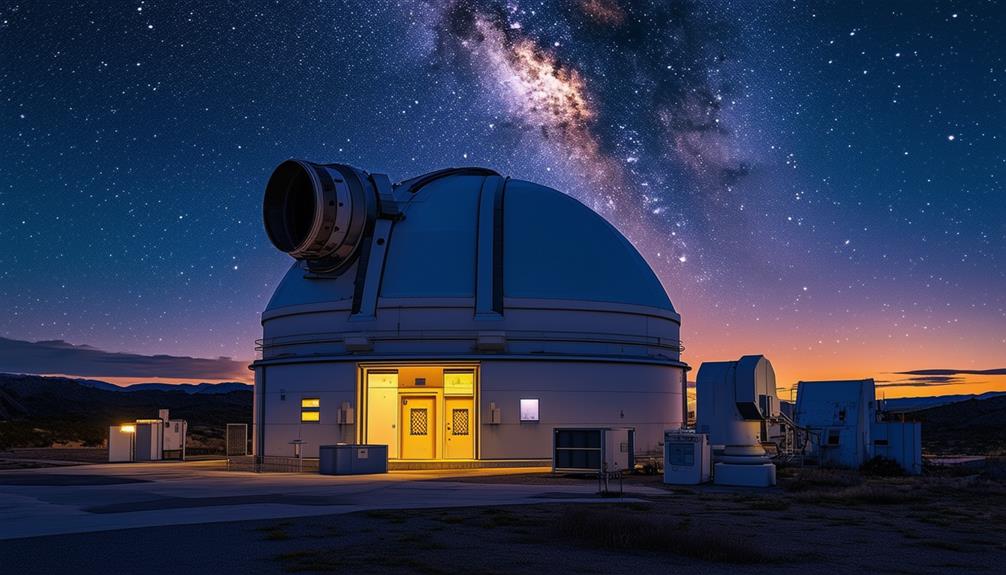
Modern ground-based observatories, such as the Very Large Telescope in Chile and the facilities atop Mauna Kea in Hawaii, leverage advanced optical instruments to explore the cosmos.
These observatories are strategically located in regions with optimal conditions—high elevations and dry climates—to minimize atmospheric distortion.
Additionally, radio telescopes like the Atacama Large Millimeter Array expand our understanding by observing wavelengths that optical telescopes can't detect.
Advanced Optical Telescopes
Modern land-based observatories have revolutionized our understanding of the universe through significant technological and infrastructural advancements. Facilities like the Keck Observatory at Mauna Kea, which features two 10-meter optical telescopes, have substantially improved our ability to observe celestial objects. Mauna Kea is a central hub for advanced observatories, hosting the world's largest collection of large optical telescopes. These observatories provide exceptional resolution and accuracy, enabling astronomers to explore the universe in unprecedented detail.
The Gran Telescopio Canarias in Spain, the largest contemporary optical telescope, exemplifies these advancements. Its sophisticated design allows astronomers to obtain detailed views of distant galaxies, star formations, and other celestial phenomena. Land-based observatories like these complement space-based telescopes by filling observational gaps and offering unique strengths.
Consider the following benefits of advanced optical telescopes:
- Enhanced resolution: Modern optical telescopes capture highly detailed images of celestial objects.
- Increased accuracy: Technological advancements enable more precise measurements and data.
- Continual improvements: Land-based observatories can be upgraded with new technologies, ensuring they remain at the forefront of astronomical research.
These innovations have transformed our understanding of the cosmos, providing insights that were once beyond our reach.
Ideal Observatory Locations
Optimal observatory sites combine dark skies, clear nights, dry air, and high elevations to enhance the quality of astronomical observations. Many major ground-based observatories are strategically positioned in regions like the United States, Spain, and Chile, which offer the ideal conditions required for cutting-edge astronomical research.
For instance, the Paranal Observatory in Chile is renowned for its advanced optical telescopes that benefit from the country's exceptional atmospheric conditions.
In addition to ground-based observatories, airborne observatories such as SOFIA (Stratospheric Observatory for Infrared Astronomy) operate at high altitudes. By doing so, they take advantage of the clearer atmospheric conditions available at those heights, which are ideal for infrared observations.
Another exemplary location for an observatory is Ridge A in Eastern Antarctica, considered one of the finest for ground-based observations due to its minimal atmospheric disturbances.
Facilities like the Atacama Large Millimeter Array in Chile demonstrate why high elevation and dry air are crucial. These conditions significantly reduce atmospheric water vapor, allowing for clearer and more precise astronomical observations.
Radio Telescope Innovations
Modern ground-based radio observatories have revolutionized our understanding of the universe by detecting radio signals with unmatched precision. These observatories, such as the Very Large Array in the United States and the Arecibo Observatory in Puerto Rico, are crucial for advancing radio astronomy.
To maximize signal clarity, these observatories are strategically located far from urban areas to minimize interference. They're equipped with control centers, visitor facilities, and data processing centers to ensure efficient management of observations. Radio telescopes have significantly expanded our knowledge of phenomena like pulsars, quasars, and the cosmic microwave background radiation.
Key contributions of radio telescopes include:
- Pulsars: These rapidly rotating neutron stars are detected and studied using radio telescopes, providing insights into their extreme physical properties.
- Quasars: Observing these distant and luminous objects helps radio telescopes shed light on the early universe.
- Cosmic Microwave Background Radiation: Radio observatories map this faint radiation, offering vital clues about the origins of the universe.
Advancements in Radio Astronomy
Radio astronomy has revolutionized our understanding of the universe by using advanced technology to observe celestial objects in the radio spectrum. Radio telescopes, which detect wavelengths ranging from millimeters to meters, have unveiled new perspectives on the cosmos.
The field was pioneered by Karl Jansky in the 1930s, who first detected radio signals from space, establishing radio astronomy as a crucial scientific discipline. The development of interferometry techniques now allows astronomers to combine data from multiple radio telescopes, producing high-resolution images of celestial phenomena previously hidden from view.
Radio telescopes enable the investigation of enigmatic objects such as pulsars and quasars. Pulsars, highly magnetized, rotating neutron stars, emit beams of radio waves detectable on Earth, revealing their presence. Quasars, the luminous centers of distant galaxies powered by supermassive black holes, also emit strongly in the radio spectrum.
These observations provide valuable insights into the structure and evolution of the universe.
Space-Based Observatories
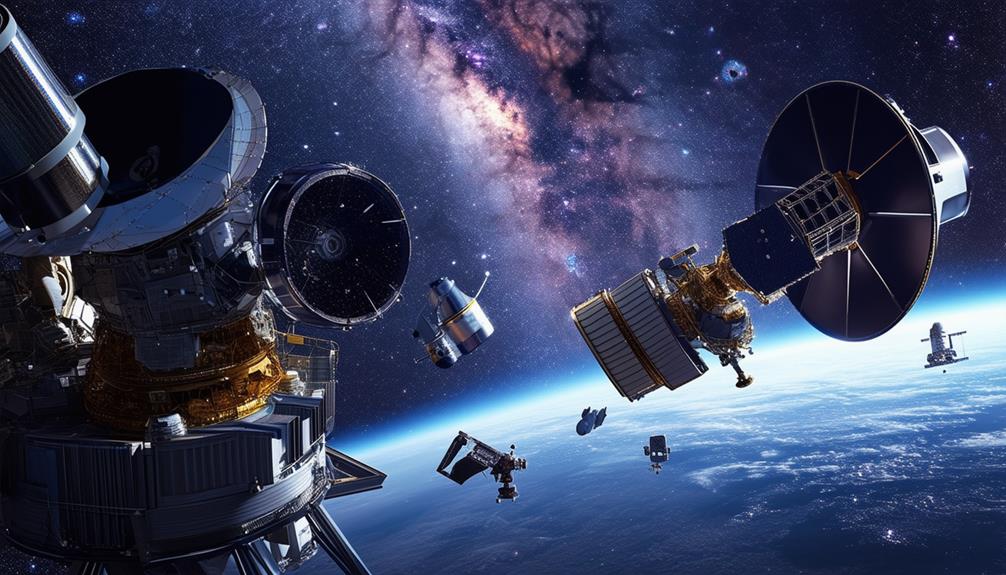
Space-Based Observatories
While radio telescopes have expanded our understanding of the universe from the ground, space-based observatories further this exploration by observing celestial objects in wavelengths that can't penetrate Earth's atmosphere.
These orbiting observatories are sensitive to specific regions of the electromagnetic spectrum, including gamma rays, X-rays, ultraviolet, and infrared radiation. This capability allows them to study cosmic phenomena like black holes, galaxies, and supernovae in unparalleled detail.
The Hubble Space Telescope and the Chandra X-ray Observatory are prime examples of space-based observatories. Positioned far above Earth's atmosphere, they provide unique perspectives and data on cosmic events and structures that ground-based telescopes can't achieve.
Instruments on these orbiting observatories have transformed our understanding of the universe.
Key points to consider:
- Unique Observations: Space-based observatories can detect wavelengths blocked by Earth's atmosphere.
- Cosmic Phenomena: They enable detailed studies of celestial objects and events, such as black holes and supernovae.
- Ideal Locations: Satellites at the second Lagrangian point (L2) offer stability and minimal interference from Earth.
Conclusion
You've journeyed through the evolution of astronomical observatories, spanning from ancient sites to cutting-edge space-based technology. Each era has contributed unique advancements, expanding our understanding of the universe.
These observatories have transformed our knowledge of the cosmos and will continue to do so. As you look up at the night sky, remember the centuries of exploration and discovery that have led to this moment. The quest to understand the universe is ongoing.



